
10-12 March 2020
We didn’t really know what to expect of Kuching, on the northwest edge of Borneo, other than rain. The average rainfall in March in Kuching is 340mm (13.4in). The Malaysian state of Sarawak, of which Kuching is the capital, has 4000mm (157in) per year. That’s a lot of rain. But we really wanted to go to Kuching – because orangutans!
Semenggoh Wildlife Rehabilitation Centre, an orangutan sanctuary and nature reserve, is easily accessible from Kuching and at the morning and afternoon feeding times you’re likely to see these wondrous primates that share 97% of their DNA with us humans. More research enticed us to this small town for the easy access to Bako National Park. So we decided we’d just go to Kuching anyway, and if it rained so what. We went expecting rain, but then, except for a light sprinkle on the third morning, we had three rain-free days! The weather gods were smiling on us.
We went to Bako and it was fantastic. We didn’t go to Semenggoh. Further research would have told us that March is the tail end of fruiting season and that when the orangutans can forage fruit for themselves in the jungle they don’t come in to be fed at the centre. The manager at our hostel discouraged us from going because there’d been none seen there for a few days. This is good news of course for the orangutans; it means they are becoming fully wild again after rehabilitation, but not such good news for the likes of Don and me.
So what of the town of Kuching? With both time and weather on our side, we discovered a charming town with a laid-back atmosphere and an easy grace. By the end of three days there this riverside town had wrapped its friendly arms around us and we were captivated. Kuching embraces the curves of the tranquil Sarawak River, the location making it a gateway between other Asian ports and the mysterious jungle of Borneo.
We arrived there at 7am, brain dead from a straight thirty hours of travel from Rishikesh. After checking into our hostel, the first thing we do is walk down to the river that slices the town in two, past the idle fishing boats,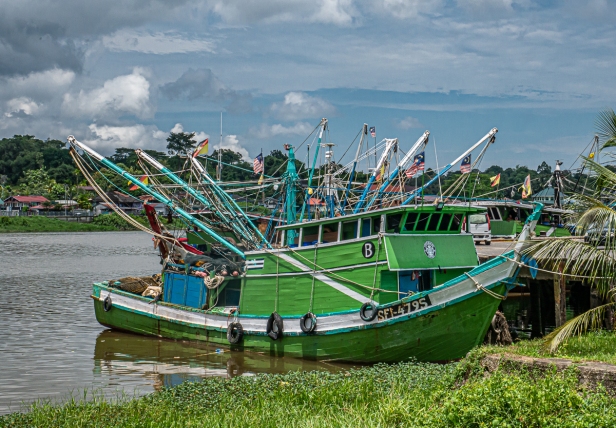
and take a lazy ride in a sampan.

As we head towards the distant bridge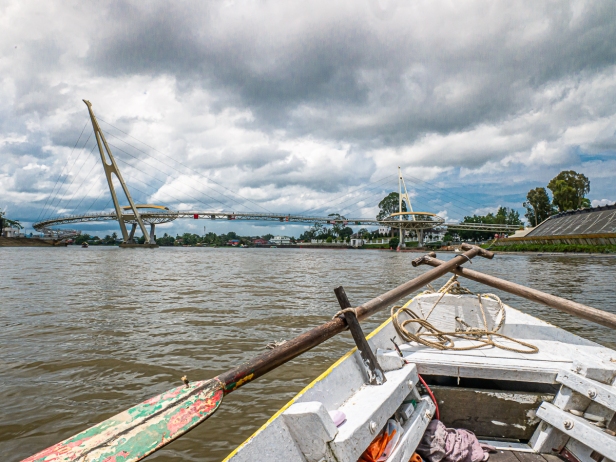
we pass the kampungs (villages) on the north side,
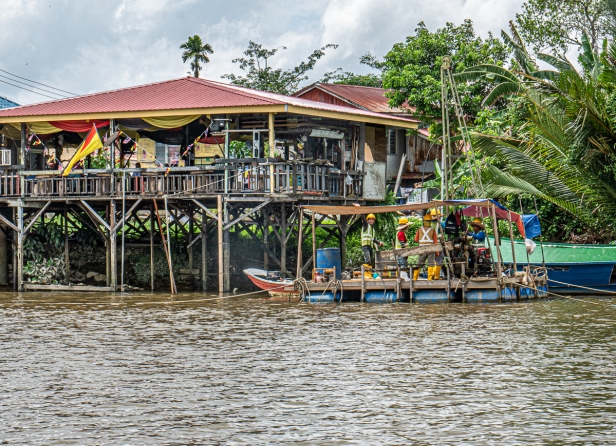
with the glowing domes of Masjid Lama (the Old Mosque) in the distance.
Fishermen and sampan boatmen

work the river, the lifeblood of the area, as we move ever closer to the Darul Hana Bridge, a mighty S-shaped structure linking the north and south parts of the city.
As we move slowly along we watch a building come closer and closer. It is so unusual as not to be dismissed, but rather to inspire curiosity and awe. It is the Sarawak State Legislative Assembly Building opened in 2009 and it dominates the riverbank.
The building is a nine-pointed star with a roof echoing that of a traditional Malaysian royal umbrella, and a cultural icon of both Kuching and Sarawak.
Our boatman turns around and takes us back to our starting point, and we return to our hostel room at the top of four weary flights of stairs, and collapse in bed for a much needed nap. Travelling life is not all doobies and chocolate cake. Sometimes you just have to stop.
There’s a thing in SE Asia called Grab. It’s the local Uber and we used it for every journey (some 10 of them) in Malaysia and it never failed us; it was always reliable, prompt, and inexpensive. The Grab driver who brought us from the airport told us about Premier 101. The best place to eat in Kuching he said. So having revived somewhat from our nap we grabbed a Grab and went to Premier 101, an enormous food court, Asian style.


The name comes from the original 101 food stalls. There are probably more now, and our first reaction was to be overwhelmed. So much choice! Where to start? We wandered around taking in the sheer size of the place, the number of stalls, and the endless varieties of food, most of which were unfamiliar to us. Finally we chose some food and one of the fancy local drinks, and sat. People meandered all throughout the space, chatting with friends, eating, and drinking beer. It felt friendly, fun, informal, the atmosphere relaxed and unhurried in the sultry tropical evening air.
I don’t remember what we ate, but it was good. All the food in Malaysia was good. Really good. At least three times, before we left Vancouver, when we mentioned to friends that we were going to Malaysia their response was about how fabulous the food is. And they were right!
The next two nights we ate at Topspot Food Court: rooftop dining with a difference. This large open-air space in central Kuching, at the top of a six-story car park, has about eight or ten restaurants all serving the same huge eating area.
The place buzzes, noisy and busy with both locals and visitors. It offers the best seafood in town, and there’s also a huge array of vegetables, including the famous Malaysian fiddleheads known as mindin. You hardly even have a chance to actually look at a menu. You wander from stall to stall, gaze at the seafood and next thing a server suggests something and then suggests some vegetables, and some rice, and off they go. How they ever find you again is a mystery but both nights we dined royally for very little and the food was excellent.


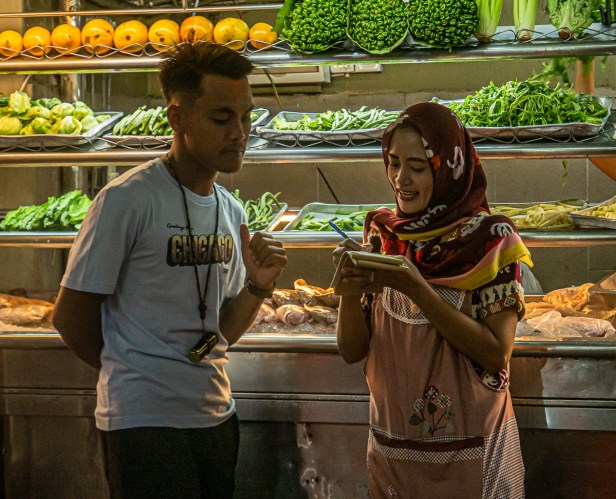
Breakfast was really good soup at the food court next door to the hostel.
We went to Sarawak Cultural Village, a living museum dedicated to preserving the indigenous cultures of the area. In retrospect it was not the best choice we could have made, and I wonder now why we didn’t get a sampan across the river and go exploring Malay life as it is today in the kampongs. In a grand attempt (17 acres!) to authentically preserve the culture of all the indigenous tribes they somehow managed to lose all authenticity. The Cultural Village was a dead zone, except for the dance performance, where each tribe showed their traditional dance. That was worth seeing.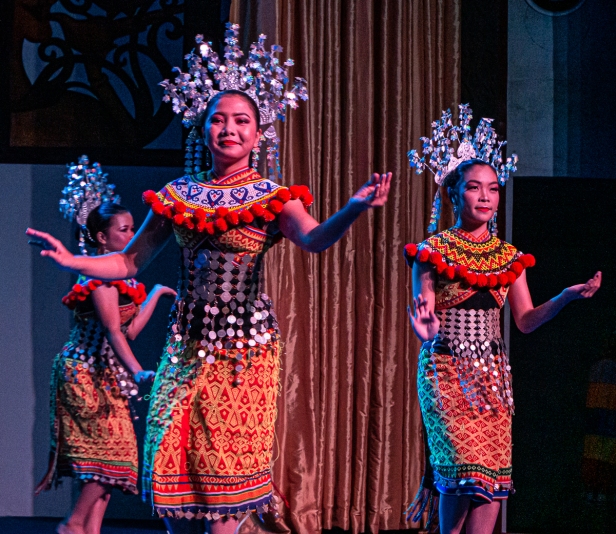

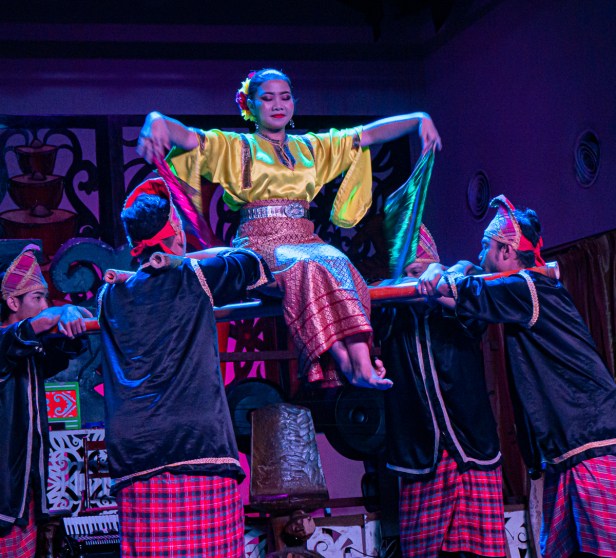



Three men held the pole firm. A fourth man shimmied up to the top
and then spread himself out like a star on top of the pole and began to twirl around!
This man entered silently from the back of the theatre, and using a blowgun he sent a dart that popped a balloon clear across the auditorium.
It was a pretty spectacular show.
In the evenings we wandered like lemmings to the river where there’s a wide boulevard
next to Main Bazaar, the oldest street in Kuching. Main Bazaar is lined with 19th century Chinese shophouses many of which have been occupied by the same family for generations.

And a little further along, at the end of Main bazaar is Tua Pek Kong Temple sitting atop a red-tiled base with a blue dragon mural, festooned with dozens of red lanterns, and topped with more dragons. It’s the most popular temple in town for Chinese residents.
We walked all the way to the bridge and across to the other side and back, stopping to admire the newly opened Floating Mosque as the end of the day approached.
Walking back along the riverside boulevard we stopped for ice cream and watched the area come alive with food stalls, and people, buskers and street performers, and a spectacular sunset turning the river first golden
and then pink.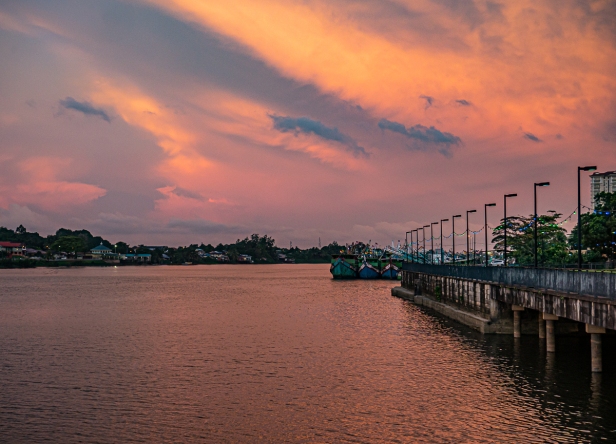
This small city of just over half a million, with its food courts, wide lazy river, and friendly people, suited our mood perfectly, and won our hearts. Meanwhile we were getting emails from friends suggesting we come home because of the corona virus pandemic. We didn’t know it had been declared a pandemic. We weren’t following the news closely and didn’t want to. Neither did we want to go home. Following our intuition we remained in our bubble and travelled on to Sepilok on the other side of Borneo – because orangutans!
Next post: We did see plenty of Orangutans – in Sepilok, which I’ll post about eventually. Meanwhile I think I’ll swing over to the holy city of Rishikesh, India for a look at all the activity in and on the banks of the sacred Ganges River. It’s an on-going carnival!
All words and images by Alison Louise Armstrong unless otherwise noted.
© Alison Louise Armstrong and Adventures in Wonderland – a pilgrimage of the heart, 2010-2020.

Love the boats and waterways. The pictures from the performance are really great as well.
LikeLiked by 2 people
Thanks so much rabirius. I’m always a bit surprised, and pleased, when my pics in low light turn out ok. Being on, and by the river was lovely, especially at sunset.
Alison
LikeLike
Your low light pictures usually are really good. You got the trick how to work the light.
LikeLiked by 2 people
Thank you!
A.
LikeLike
How is it you are travelling when all countries are in lockdown? Or is this an old article from 2019?
LikeLiked by 1 person
It’s not old. It’s was in March this year. The dates are at the very beginning of the post, right under the first photo. We got back to Canada March 21st. You’ll find the story of getting back to Canada here: https://alisonanddon.com/2020/03/19/love-in-the-time-of-corona-finding-our-way-home/
Alison
LikeLike
Glorious photos, colors and textures. Love the narrative as well.
LikeLiked by 2 people
Thanks so much Cindy. It was a lovely place; a good first ever experience of Malaysia.
Alison
LikeLike
Kuching sounds like a lovely spot. You tend to find the best part of every place you visit. I’m looking forward to orangutangs.
LikeLiked by 2 people
We had no idea what to expect, but Kuching was just delightful. I think we mostly found the best parts, but wish we’d opted for a little exploration across the river, and gone to see the inside of that beautiful new mosque. Oh well. Next time . . . .
Alison
LikeLiked by 1 person
Awesome photos!
LikeLiked by 2 people
Thank you so much.
Alison
LikeLiked by 1 person
The word that comes to mind when looking at your photos is “heat”. Looks like a tranquil city.
LikeLiked by 2 people
Ah, that’s a good word. It *was* hot, and we loved it. I’m definitely a tropical baby at heart. Yes, Kuching as tranquil. It was an easy place to be.
Alison
LikeLiked by 1 person
Such an interesting contrast on the riverbanks from the tall modern buildings to the more modest structures on stilts later on. Yes those recreated cultural villages in our experience, tend to be tourist traps. We visited one somewhere in Laos I think and swore, never again…. haha.
We really enjoyed the food in Malaysia as well ~ there is a tremendous variety of interesting choices.
Peta
LikeLiked by 2 people
There really *was* a contrast between the two sides of the river – the main city and downtown on one side and the villages on the other. I do wish we’d gone exploring across the river. Wandering through villages, away from the city, is one of my favourite things to do. And I’m definitely with you on the cultural villages – never again! It was sad actually. Every tribe had a recreated building, and people there to demonstrate crafts, but there was no energy to it – except for the dance performance which was great.
Alison
LikeLike
Love the setting sun shots. Pandemic or orangutang? Easy choice! 🙂 🙂
LikeLiked by 1 person
Hi RJo!! 🙂
LikeLiked by 2 people
Thanks Jo. Tropical sunsets seem to be pretty much always spectacular, and Kuching was no exception. Orangutangs rule!
Alison
LikeLike
If only they did, hon! 🙂 🙂
LikeLiked by 2 people
Chuckle. Yes, really!
A.
LikeLiked by 1 person
Alison – what a lovely post. It’s been a while since I ventured into wordpress, and it was so much fun to catch up on your adventures. I noticed you are currently in Vancouver, so wondered about the date of your travel and how you got back to home during this no-travel time, but I suppose I’ll have to wait for that story! Meanwhile, good health to you and Don – Susan
LikeLiked by 1 person
Thanks so much Susan. Lovely to hear from you! We were in Kuching in March this year. You’ll find the story of getting back to Canada here:
Alison
LikeLiked by 1 person
Awesome post & snap shots. Added to my places to visit
LikeLiked by 2 people
Thanks so much. I hope you get there one day. I don’t think you’ll be disappointed. What we saw of Borneo was quite fabulous and I wish we could have continued our trip to the other places in Malaysia we’d planned on visiting.
Alison
LikeLiked by 1 person
Were visiting Malaysia this June to visit a friend living there. Maybe soon
LikeLiked by 1 person
Gorgeous photos and narrative, Alison. We also did the river walk in Kuching and it’s beautiful to see the area again through your photos. It leaves me wishing we had spent more time there. And the outdoor food courts! Such an integral part of life in Asia. I miss them — the variety of food, the energy, the people spending time together. So looking forward to the day when this is all possible again.
LikeLiked by 1 person
Thanks so much Kelly. I would have loved to have more time in Kuching, and all of Borneo! What a special place it is. And yes the food courts! So fabulous. I think it may be a while before we get to experience that again 😦 . Even with things opening up Don’s not getting in any flying tin can anytime soon.
Alison
LikeLiked by 1 person
Wow I wanted to get to Malaysia this year and now I want to go more!
LikeLiked by 2 people
Oh I do hope you get there Heather. We only had 8 days there, all on the island of Borneo. Our trip was cut short by the pandemic, but we loved what what we saw.
Alison
LikeLiked by 1 person
I hope so too!! I’m sure I will…just a question of when
LikeLiked by 1 person
How resourceful to make something so positive out of not seeing what you came for!
LikeLiked by 2 people
Oh I just want to give you a big hug! (You know why.) I think we weren’t that disappointed in not seeing the orangutangs because we felt reasonably confident we’d see them in Sepilok, which turned out to be the case. And Kuching is such a lovely town that it wasn’t hard to make lemonade 🙂
Alison xo
LikeLike
Love those low-key, laid-back kind of places. They always have a lot to offer. And the food courts look great. As always, great photos.
LikeLiked by 2 people
Thanks Tracey. Kuching was a surprise. We’d never been to Malaysia and had no idea what to expect. And the food courts! I’d go back just for them lol.
Alison
LikeLike
Kuching looks totally charming and that Legislative building has such unique style. It looks like a nice, easy-going city to hang out in for awhile. I was on peninsular Malaysia many years back and had such a great time (and remember the delicious food). I’ve always hoped to return and this time go to Borneo. Your posts are very enticing.
LikeLiked by 2 people
Thanks Caroline. We really enjoyed our brief foray into Malaysia; only Borneo, we don’t count the 3 days in KL during lockdown. Kuching was a lovely surprise that grew on us until by the end we were saying what a lovely city it is. So mellow, and with the beauty of the river and distance mountains. And the food courts! Borneo is definitely worth visiting. I wish we’d been able to explore there more, and also go to Brunei. One day . . . .
Alison
LikeLiked by 1 person
So miss this part of the world. We never made it to Kuching while visiting Malaysia, so I much appreciate the virtual tour. You’ve given me another reason to go around again. Your images are exceptional, as always. Especially love the boats.
LikeLiked by 2 people
Thanks so much Lisa. We loved what we saw of Malaysia – only 8 days and only on Borneo and then the country shut down and we had to get back to Canada. Like you I’d love to go back. I miss that part of the world too. Just thinking about the food makes me long for it 🙂
Alison
LikeLiked by 1 person
Everything about this post makes me nostalgic for travel in general. I’ve never been to Malaysia, but pieces of Kuching reminded me of so many other destinations, and I felt a pang wondering when I might next float on a faraway river or eat exotic foods with hundreds of other people in a big plaza. The legislative building is magnificent; it almost looks fake in its perfection!
LikeLiked by 2 people
I too am nostalgic for travel 😦 and I honestly wonder if I’ll ever travel again (virus, age, and underlying health conditions in one or other of us). This is a good time for me to really focus on presence, and contentment with what is. But! Just in case *you* get to travel again Malaysia is definitely worth a visit. Limited experience (only 8 days and only on Borneo) but we loved it and I’d like to go back and explore more.
Alison
PS and suddenly I’m filled with the thought “Of *course* I’ll travel again!” lol. (When the current madness is over)
LikeLiked by 1 person
Ooh I’m so keen to get to Borneo! I’ve read its bad for kidnappings though – any concerns?
LikeLiked by 2 people
Borneo is fabulous and we had no concerns at all, though we had heard the same – and that it applies to the east coast. Still we went to Sepilok (northeast), which was the *best* place to see orangutangs and it was heaven. Will post about it soon.
Alison
LikeLike
Kuching has always been on top of my list of places in Malaysia that I want to see — all of my past travels were always to the western part of the country. I’m intrigued by the food, the legislative building, and cats-related things in the city (in Malay, kucing means cat). Due to its relative proximity from Jakarta, maybe I really should prioritize this city when international travel is possible again.
LikeLiked by 1 person
Kuching is just lovely Bama. I knew all about the cat thing of course, but for some reason that’s not what grabbed me when I was there. I read an explanation of the likely origin of the name of the city and both ideas actually had nothing to do with cats. Nevertheless there are some cute cat statues there. The food is truly outstanding, and the legislative building fabulous. There’s also a castle that belonged to the “White Rajas” that James mentioned. Hope you get there one day!
Alison
LikeLiked by 1 person
I’ve been wanting to visit Kuching for ages now, and am so glad you and Don fell in love with the place! Being a foodie, the prospect of sampling local dishes like Sarawak laksa and then taking a hands-on cooking class really excites me. And the riverside has so much charm. My parents used to live in Malaysia way before I was born and I grew up hearing stories of my dad’s regular trips to Kuching and its fascinating history. He told me Sarawak was given to a British trading family (the Brookes) by the Sultan of Brunei as a gift, and so for about 100 years it became a kingdom ruled by “White Rajas”. Did you see any traces of that period in the buildings downtown or along the river?
LikeLiked by 1 person
I do hope you get there. There’s not a lot of razzmatazz – it’s just a quiet town on a river with a lovely vibe, some interesting buildings, and truly fabulous food. I did read about the Brookes family but chose not to go into Kuching’s history here. It’s actually a pretty interesting story, and yes there are buildings along the river – a mansion I think, and definitely a huge white Castle!
Alison
LikeLiked by 1 person
We loved Kuching and Baku and orangutans. But Topspot mostly:) My 4 kids grew tired of eating lobster and huge blue prawns and other delicacies. Amazing area. DId you see the pink irrawaddy dolphins and lightening bugs? Such a great area.
LikeLiked by 1 person
We also loved Kuching and Bako. And yes Topspot! what a fabulous place. Sadly we didn’t see any pink dolphins or lightening bugs 😦 but I agree – a great area. I’d love to explore Borneo more.
Alison
LikeLike
Sarawak was probably among the better places to be stuck in during the pandemic, to be honest. BTW, it’s orangutan (orang = person, utan is an old spelling of hutan = forest). Orangutang sounds like you’re speaking a Terengganu dialect!
LikeLiked by 1 person
We weren’t stuck in Sarawak. I kinda wish we had been. We went to Sepilok and stayed for 3 days and then found out the country would be closing down and that we had to get back to Canada. Our plan had been to visit several other places in Malaysia but sadly we were stuck in a completely shut down Kuala Lumpur for 3 days before we could get a flight. At least our hotel was nice.
I’m a bit behind the times with orangutan lol. I was raised with the g on the end as that was the correct English spelling and the dictionary still lists both spellings, tho I understand that adding the g is now considered incorrect. I suppose I should fix it so I don’t look like I can’t spell lol. What’s the English translation of orangutang in the Terengganu dialect into English?
We loved Malaysia and were sad to have our visit cut short 😦
Alison
LikeLike